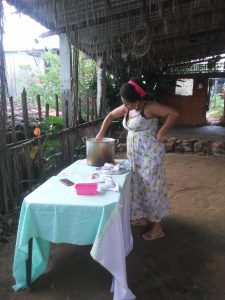Floods in Rio Grande do Sul, Brazil: chronicle of a tragedy
By Alisson Droppa and Lara Nasi, on 14 June 2024

Here we write about the greatest climate tragedy ever experienced in Rio Grande do Sul (RS), Southern Brazil. In many ways, it may be the biggest Brazilian climate tragedy. A survey carried out by Folha de S. Paulo newspaper shows that the number of 600 thousand people displaced by the flood is the highest in relation to all other disasters provoked by rains in Brazil. Until the end of May, there are 169 dead people, 50 missing ones and more than 800 injured. In total, it is estimated that 2,3 million have been affected.
Maybe this tragedy is the one that finally reinforces the idea that this scenario is a result of climate change, putting the clime in the agenda of media and social media. But with the destruction caused by the flood that affected 450 of the state’s 497 municipalities and left entire cities in ruins, the questions remains: could it be any different?
The abandonment of a protection system
Porto Alegre, the capital of Rio Grande do Sul, had 46 of its 96 neighborhoods affected. It is from the capital, which is still under water in many places, including downtown, that, while we write, we found clues that the outcome of this story could have been different.
In the 70’s, Porto Alegre built an important and robust system of protection to avoid other floods like the one in 1941, so far the biggest ever registered. It included 42 miles of earth dikes, a 1.6 miles wall along Mauá avenue, on the banks of Guaíba River, 14 floodgates along the wall and several pump houses spread throughout the city.
In 2017 the city hall decided to extinguish the municipal body responsible for its maintenance, the storm sewer department, to cut costs. The dispersion of responsibilities and technical knowledge has hidden a maze of faults and disinvestment that have been occurring over time and that became visible just when the system should fulfill its function. Instead, it collapsed. Many floodgates were stuck and there were several other structural problems that put Porto Alegre, literally, under water.
If the tragedy is announced, everyone knows prevention would be better
We cannot say that what is happening in Rio Grande do Sul is a big surprise, at least not for government officials and scientists. On the one hand, there were many studies indicating that, with global warming increase, Rio Grande do Sul would experience major floodings (and the state actually had a big and concerning flood in September 2023 that destroyed many cities). This data had been pointed out, for example, in the Brazil 2040 study, commissioned by federal government, during Dilma Roussef’s presidency, but was considered alarmist and then was shelved.
On the other hand, knowing about this and other studies and warnings, government officials preferred to ignore it and keep with the agenda of shrinking the state and handing it over for the private sector. Governor Eduardo Leite stated that he was aware of the warnings, but his priority was the fiscal agenda. Rio Grande do Sul even commissioned a disaster prevention plan in 2017, as reported by Agência Pública, that never got off the ground. There is also a decline in investment in Civil Defense, for example, as well as in the project to manage responses to natural disasters.
Moreover, Eduardo Leite’s administration had changed almost 500 points of Rio Grande do Sul Environmental Code, dismantling environmental protection framework in the state. It is not something just local. In Brazil, during Bolsonaro’s presidency, there was open incentive to deforestation, without any constraint.
The legacy is painful for those who live the results of environmental tragedy. And it persists. Lula’s administration, which has been acting to minimize the tragedy with programs and emergency social policies, needs to deal with misinformation and denialism that disturb even aid for those affected by the tragedy, as well as intend to minimize the presence of State as an articulator of both prevention and solutions to the crisis. The ode to privatisaion and the disassembling of State persists in the legislature. During the crisis in Rio Grande do Sul, federal deputies put forward the so-call “Destruction Package”, a set of at least 25 bills against environmental legislation already established.
The path, therefore, we know will be long. If there is no change in the political logic capable to stop environmental destruction and redirect public investment in preventing disasters and tragedies resulting from climate change, we know this is just a beginning of a new cycle which is not encouraging at al.
Help to rebuild RS
Trade Unions, social movements and civil society are intensely helping to rebuild the state and to assist affected families. Even though, after more than a month with many cities under the water, Rio Grande do Sul is still in the emergency phase of the tragedy. The upcoming ones are going to be long and costly. Human losses are irreparable and material ones are estimated in billions of reais. Here is how to donate:
Movimento dos Trabalhadores Rurais Sem-Terra (MST)
MST is organizing a campaign to support rural populations affected, smallholder family farmers. Read more information here.
Movimento dos Trabalhadores Sem-Teto (MTST)
Solidarity Kitchens
MTST, which already has a solidarity kitchen in Porto Alegre, now needs help to
increase production and be able to assist more people in this calamity. Read more information.
PIX: enchentes@apoia-se
Central Única dos Trabalhadores (CUT-RS)
CUT Trade Union is running a solidarity emergency campaign to help families affected by the floods. Read more information.
For donations:
– Cresol Bank (133)
– Agency 5607
– account: 18.735-6
– CNPJ: 60.563.731/0014-91
– PIX: 51996410961
– Donations of products and merchandise
This kind of donation is tax exempt. The donor simply needs to take the goods to a carrier of their choice and indicate as recipient of the donation the CNPJ of the Ministry of Foreign Affairs: CNPJ: 00.394.536/ 0006-43.


Read more IRDR Blogs
Follow IRDR on Twitter @UCLIRDR
 Close
Close








